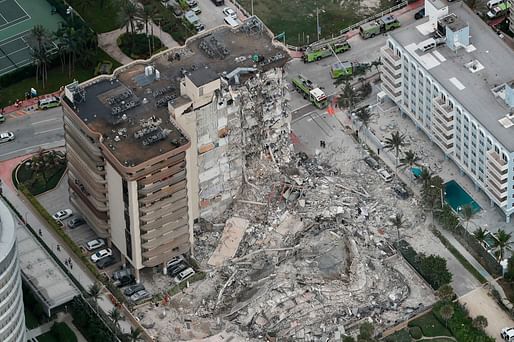

Almost one week after a Miami apartment complex partially collapsed, a 2018 report has resurfaced which warned of “major structural damage” to the base of the building. As reported by The Guardian and The New York Times, the 2018 survey identified a failing concrete slab on the pool deck and “abundant crackling and crumbling” to an underground parking garage. The report, prepared by engineers at Morabito Consultants, warned that “most of the concrete deterioration needs to be repaired in a timely fashion.”
The report highlighted a “major error” in the original design of the building’s lower levels. “The main issue with this building structure is that the entrance drive / pool deck / planter waterproofing is laid on a flat structure,” the report reads. “Since the reinforced concrete slab is not sloped to drain, the water sits on the waterproofing until it evaporates. This is a major error in the development of the original contract documents.”
The waterproofing below the pool deck and entrance level was also found to be beyond its useful life and was in need to complete removal or replacement. “The failed waterproofing is causing major structural damage to the concrete structural slab below these areas,” the report continues. “Failure to replace the waterproofing in the near future will cause the extent of the concrete deterioration to expand exponentially.” Elsewhere, the report notes “abundant cracking” of columns, beams, and walls in the complex’s parking garage.
Despite these observations, the report does not suggest the building was at imminent risk of collapse, but notes that repairs should be carried out in “a timely fashion.” The cause of the collapse remains under investigation.

Meanwhile, local news outlet NBC 6 South Florida has obtained recent drawings and bid documents that reveal the scope of the concrete restoration and repair works being sought for the building at the time of its collapse. The document, comprising 200 pages of specifications, reveal an extensive demolition, repair, and replacement project being sought by the condo owners’ association in the order of $10 million.
While the documents offers further evidence that the building was in need of major structural repair, NBC 6 also notes a warning from engineers familiar with the project that the scope of works required were not unusual for a building of this size, age, and location.
2 Comments
I owned condos for over a decade. They are run by BOD’s comprised of owners who have the most time on their hands. The politics of board membership is just as thick as in DC.
Property managers are not trained to properly handle building maintenance and repairs.
Condo boards are quicker to deal with dogs pooping on the property then handling major structural issues. If a engineer threw up red flags, it’s purely left to the board of directors to handle it. On top of it all, board members and property management are indemnified from all liability whether it’s from negligence or not.
I will never own a condo again.
In three projects in which I had the opportunity to work on for two consulting firms, we encountered similarities in the conditions described in this case. The degree of deterioration of the concrete due to the leaks from the pools, in two cases they were located over their garages, and a third due to the leaks from planters and walkways around the courtyards onto the garages became obvious. The reaction of the chlorine and other typical chemicals inherent to the treatment of the pool's water and the irrigation system were obvious, as it was observed in the decaying of both materials, concrete and reinforcement.
The observed deterioration was so severe, that the concrete was disintegrating by spalling and cracking, to the extent that the reinforcement not only became exposed, but also showed an extensive degree of corrosion, to the point that the integrity beyond the observed areas, without extending further the investigation into the embedded portions of the steel, the life of the reinforcement was basically lost by delaminating. This conditions left the structures in jeopardy with the potential of collapsing.
Unfortunately, due to the cost of the estimated repairs were beyond of what the HOA's anticipated to invest, the lack of emergency funds, and no financing available, forced to end our services with the recommendations never executed at the time. The bottom line is, without having any information until the Forensic assessment is concluded, other than the one described in the consultant report, the possibility that other undetermined conditions, may also have been contributing factors, yet their initial findings of three years ago appear to be consistent with the previous cases and conditions in which I found myself while working for such firms.
I hope you find this information useful.
Block this user
Are you sure you want to block this user and hide all related comments throughout the site?
Archinect
This is your first comment on Archinect. Your comment will be visible once approved.